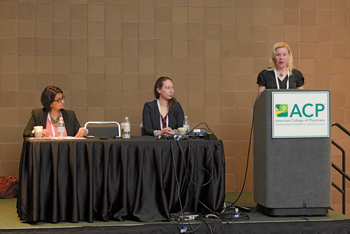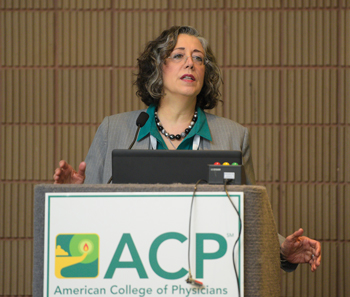Solving mysterious chronic cough cases
Chronic cough is the third most common reason for ambulatory care visits, but not all affected patients can receive specialist care. A few pearls can help uncover the origins of the condition.
Treating chronic cough involves tackling a multifactorial disease in two-thirds of cases, so take time to understand the whole picture, said Kenneth W. Altman, MD, PhD, at his talk on the subject at Internal Medicine Meeting 2018.
“[Chronic cough] is a mystery,” said Dr. Altman, professor and vice chair for clinical affairs and director of the Institute for Voice and Swallowing at Baylor College of Medicine in Houston. “The longer you take to get to the bottom of it, the longer it's going to take to improve their quality of life—and the more it's going to cost them in their life functions.”

He put some numbers on the prevalence of chronic cough. “It's really a worldwide problem,” with a prevalence of 10% to 12% of the global population at any given time. In 2013, U.S. sales of over-the-counter cough and cold remedies totaled $6.8 billion.
In the U.S., chronic cough is the third most common reason for ambulatory care visits, after general medical exams and nonspecific progress visits. Of the more than 1 billion ambulatory care visits tracked by the National Ambulatory Medical Care Survey in 2010, 31 million people had cough as a symptom, compared to 19 million for prenatal visits, 13 million for diabetes, or 13 million for hypertension, Dr. Altman said.
Given those numbers, not all affected patients can receive specialist care. “If you feel like we [otolaryngologists] should be involved in chronic cough, there's really a wholly unmet need,” he said. “It's more important for internal medicine doctors to be empowered in the front lines of caring for cough.”
Overlapping causes
Chronic coughs are those that continue for more than eight weeks, or in the case of one patient, more than 30 years. Dr. Altman recalled this patient, a 71-year-old man who had been chief financial officer for an oil company (but with no field exposure to chemicals). He had a lifelong history of allergies and had been treated as a child with shots. His main symptom was longstanding, persisting morning nasal congestion with nonproductive cough after eating a small amount of food.
His medicines included an older angiotensin-converting-enzyme (ACE) inhibitor, ramipril, that he had taken for 30 years. “How long has the coughing been going on?” Dr. Altman asked the patient, who replied, “Thirty years.”
The case illustrates the many factors that need to be taken into account in cough diagnosis, including how symptoms and possible causes can overlap. In this case, Dr. Altman said he had to distinguish among possible causes such as the ACE inhibitor, allergic rhinitis, postcibal reflux, and microaspiration.
In general, Dr. Altman said, the most common single causes of cough are tobacco use, postnasal drip, gastroesophageal reflux disease/laryngopharyngeal reflux, bronchitis, reactive airway disease, and the use of ACE inhibitors. But there's often more than one cause, he continued.
He recommended that internists follow the American College of Chest Physicians' guideline on diagnosis and management, whose recent updates started in 2014 are continuing. In this guideline, systematic reviews inform recommendations on 42 clinically important topics. A panel of 55 worldwide experts in 21 disciplines develop, publish, and update the recommendations according to a “living guidelines model.”
When assessing patients, first ask about lifestyle and medical history, including profession, personal life, exposures to potential triggers, and smoking, Dr. Altman advised. Then, per the 2014 guideline, order a chest X-ray for a chronic cough lasting longer than two months. Sometimes the findings are unexpected: “I found tuberculosis in one patient,” he said. Then, take patients off ACE inhibitors. “If there's one message I leave you with today, that's the most important one.”
Given the multifactorial nature of chronic cough, in cases where empiric treatment has failed, he prefers to conduct diagnostic testing “rather than shooting from the hip and throwing medicine at them.” He later added, “I'm not trying to save any money here on the up-front testing.”
Testing can include allergy assessments and sinus CT scans. For allergy testing, Dr. Altman does a serology on the 18 most common allergens in Texas.
If a patient is found to have cough of pulmonary etiology, empiric therapy includes bronchodilators and steroids. Objective testing includes pulmonary function testing, a methacholine challenge, chest CT, and bronchoscopy, Dr. Altman said.
For esophagus-related coughing, empiric therapy includes proton-pump inhibitors, management through diet and lifestyle, alginates, and motility agents, he noted. If these don't work, conduct a barium swallow or 24-hour pH test, among others, he said.
Pearls to look for
When digging into the causes of cough (Table), Dr. Altman begins with rhinologic causes, such as allergic and nonallergic rhinitis and sinusitis. The conditions can interact and the resulting mucus can clog the natural drainage route and cause a bacterial infection, triggering cough.
Age can be a clue. When Dr. Altman sees younger patients, he said, “You're not thinking about cancer as much. You're not thinking about congestive heart failure.” An internist can be less suspicious of chronic lung disease if the patient doesn't smoke and can be less suspicious of allergy unless it's in the patient's history.
Reflux can cause cough, and there are several ways it can play out. As people age, they eventually begin to microaspirate after eating, he said. But in younger patients, when cough is worse after eating, the larynx is performing its evolutionary function of protecting the airway during reflux.
He reminded attendees that for patients who have suspected reflux or who have been on heartburn medicine for years, the empiric test for reflux is not response to medicine; it's a pH probe. “Cough is prominent in this form of reflux. So reflux can certainly trigger cough.”
The unified airway
Absence of productive cough can be a misleading symptom, because sometimes patients don't have the strength in their lungs to have a full expulsive cough. “Sometimes people swallow it instead,” Dr. Altman said. He reminded attendees that the upper and lower respiratory tracts are interconnected, which can mask symptoms.
The unified airway can play out in several combinations of conditions.
Allergy and sinusitis. In the nose, allergy is commonly seen in patients with chronic sinusitis, because the narrow sinus drainage pathways tend to swell shut in the presence of thick, opaque mucus, and then bacteria overgrow, he said.
Allergy and asthma. This is a common combination that leads to cough. “I think that's in everyone's practice.”
Sinusitis and asthma. “We know that when people have sinusitis and pre-existing asthma, their asthma is going to get worse. It's common for someone with chronic sinusitis to get asthmatic bronchitis,” Dr. Altman said.
Asthma and bronchitis. This common combination is especially prevalent among smokers, he noted.
Neurologic etiologies
Cough may also have neurologic causes. Empiric therapy for this kind of cough includes pharmacologic suppression, respiratory retraining, and laryngeal desensitization. Objective testing may include an MRI of the brain, modified barium swallow, and laryngeal electromyography.
The latest evidence shows that gabapentin can be used for neurologic coughs, Dr. Altman added. Also, behavioral suppression can retrain patients. Speech therapists teach methods such as dry swallow, use of ice water, conscious awareness of triggers, and early recognition and avoidance of cough.
“I don't like to spend too much time on empiric therapy if it's not working. I like to jump to the bottom of it so our patients are not those that come in six years later, or 20 years later, living with this chronic cough,” he said.





